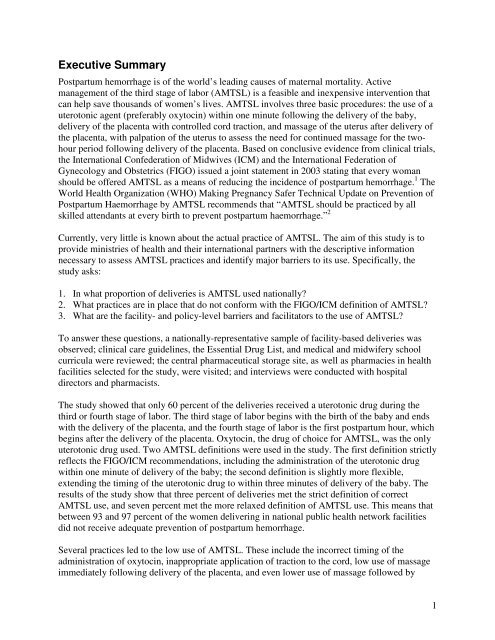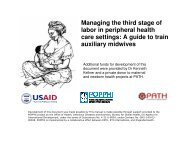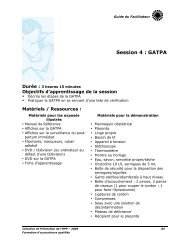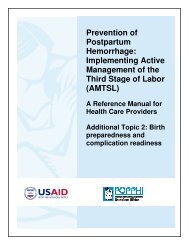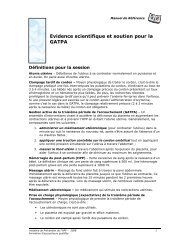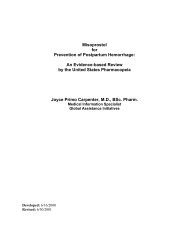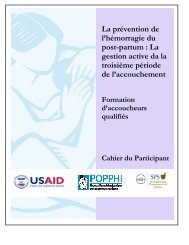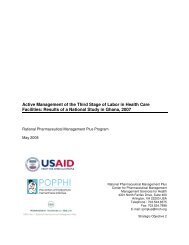El Salvador - Active Management of the Third Stage of Labor - POPPHI
El Salvador - Active Management of the Third Stage of Labor - POPPHI
El Salvador - Active Management of the Third Stage of Labor - POPPHI
You also want an ePaper? Increase the reach of your titles
YUMPU automatically turns print PDFs into web optimized ePapers that Google loves.
Executive SummaryPostpartum hemorrhage is <strong>of</strong> <strong>the</strong> world’s leading causes <strong>of</strong> maternal mortality. <strong>Active</strong>management <strong>of</strong> <strong>the</strong> third stage <strong>of</strong> labor (AMTSL) is a feasible and inexpensive intervention thatcan help save thousands <strong>of</strong> women’s lives. AMTSL involves three basic procedures: <strong>the</strong> use <strong>of</strong> auterotonic agent (preferably oxytocin) within one minute following <strong>the</strong> delivery <strong>of</strong> <strong>the</strong> baby,delivery <strong>of</strong> <strong>the</strong> placenta with controlled cord traction, and massage <strong>of</strong> <strong>the</strong> uterus after delivery <strong>of</strong><strong>the</strong> placenta, with palpation <strong>of</strong> <strong>the</strong> uterus to assess <strong>the</strong> need for continued massage for <strong>the</strong> twohourperiod following delivery <strong>of</strong> <strong>the</strong> placenta. Based on conclusive evidence from clinical trials,<strong>the</strong> International Confederation <strong>of</strong> Midwives (ICM) and <strong>the</strong> International Federation <strong>of</strong>Gynecology and Obstetrics (FIGO) issued a joint statement in 2003 stating that every womanshould be <strong>of</strong>fered AMTSL as a means <strong>of</strong> reducing <strong>the</strong> incidence <strong>of</strong> postpartum hemorrhage. 1 TheWorld Health Organization (WHO) Making Pregnancy Safer Technical Update on Prevention <strong>of</strong>Postpartum Haemorrhage by AMTSL recommends that “AMTSL should be practiced by allskilled attendants at every birth to prevent postpartum haemorrhage.” 2Currently, very little is known about <strong>the</strong> actual practice <strong>of</strong> AMTSL. The aim <strong>of</strong> this study is toprovide ministries <strong>of</strong> health and <strong>the</strong>ir international partners with <strong>the</strong> descriptive informationnecessary to assess AMTSL practices and identify major barriers to its use. Specifically, <strong>the</strong>study asks:1. In what proportion <strong>of</strong> deliveries is AMTSL used nationally?2. What practices are in place that do not conform with <strong>the</strong> FIGO/ICM definition <strong>of</strong> AMTSL?3. What are <strong>the</strong> facility- and policy-level barriers and facilitators to <strong>the</strong> use <strong>of</strong> AMTSL?To answer <strong>the</strong>se questions, a nationally-representative sample <strong>of</strong> facility-based deliveries wasobserved; clinical care guidelines, <strong>the</strong> Essential Drug List, and medical and midwifery schoolcurricula were reviewed; <strong>the</strong> central pharmaceutical storage site, as well as pharmacies in healthfacilities selected for <strong>the</strong> study, were visited; and interviews were conducted with hospitaldirectors and pharmacists.The study showed that only 60 percent <strong>of</strong> <strong>the</strong> deliveries received a uterotonic drug during <strong>the</strong>third or fourth stage <strong>of</strong> labor. The third stage <strong>of</strong> labor begins with <strong>the</strong> birth <strong>of</strong> <strong>the</strong> baby and endswith <strong>the</strong> delivery <strong>of</strong> <strong>the</strong> placenta, and <strong>the</strong> fourth stage <strong>of</strong> labor is <strong>the</strong> first postpartum hour, whichbegins after <strong>the</strong> delivery <strong>of</strong> <strong>the</strong> placenta. Oxytocin, <strong>the</strong> drug <strong>of</strong> choice for AMTSL, was <strong>the</strong> onlyuterotonic drug used. Two AMTSL definitions were used in <strong>the</strong> study. The first definition strictlyreflects <strong>the</strong> FIGO/ICM recommendations, including <strong>the</strong> administration <strong>of</strong> <strong>the</strong> uterotonic drugwithin one minute <strong>of</strong> delivery <strong>of</strong> <strong>the</strong> baby; <strong>the</strong> second definition is slightly more flexible,extending <strong>the</strong> timing <strong>of</strong> <strong>the</strong> uterotonic drug to within three minutes <strong>of</strong> delivery <strong>of</strong> <strong>the</strong> baby. Theresults <strong>of</strong> <strong>the</strong> study show that three percent <strong>of</strong> deliveries met <strong>the</strong> strict definition <strong>of</strong> correctAMTSL use, and seven percent met <strong>the</strong> more relaxed definition <strong>of</strong> AMTSL use. This means thatbetween 93 and 97 percent <strong>of</strong> <strong>the</strong> women delivering in national public health network facilitiesdid not receive adequate prevention <strong>of</strong> postpartum hemorrhage.Several practices led to <strong>the</strong> low use <strong>of</strong> AMTSL. These include <strong>the</strong> incorrect timing <strong>of</strong> <strong>the</strong>administration <strong>of</strong> oxytocin, inappropriate application <strong>of</strong> traction to <strong>the</strong> cord, low use <strong>of</strong> massageimmediately following delivery <strong>of</strong> <strong>the</strong> placenta, and even lower use <strong>of</strong> massage followed by1


